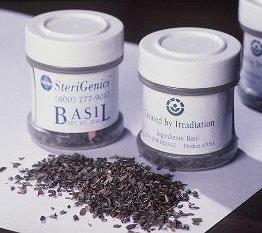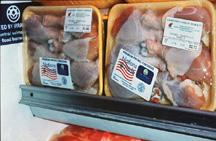
 |
Why Irradiate Foods? |
Spices and Herbs
| Most herbs and spices are grown outside, resulting in a large number of microorganisms, some of which could be hazardous to health, and which could carry insects or insect eggs. Because heat treatment can cause significant loss of flavor and aroma, a "cold" process is necessary. Most spices and herbs are fumigated, usually with ethylene oxide to destroy these contaminates. This fumigant is being phased out for environmental and health reasons. Irradiation is as effective without the environmental or residue constraints of fumigants. |  |
| Fruits and Vegetables
|
A very low-dose irradiation treatment inhibits sprouting
of vegetables such as potatoes, yams,
onions, garlic, ginger, and chestnuts, and can replace chemicals that are currently used for this purpose. Low-dose irradiation can kill or sterilize all the developmental stages of insects pests in grain. Dried fruits, vegetables, and nuts are liable to insect attack, and some cannot be effectively disinfected by either chemical or physical means other than irradiation. |
Irradiation disinfestation can increase trade in certain tropical fruits, such as citrus fruit, mangoes, and papayas. Food irradiation offers a residue-free means of preventing the importation of harmful insects, such as the Mediterranean fruit fly. Irradiation treatment offers an alternative to fumigation to satisfy the quarantine regulations in a number of countries.
Exposure to a low-dose of food irradiation delays the ripening and therefore extends the shelf-life of some fruits and vegetables.
Meat, Poultry, and Pork
Food irradiation makes food safer by destroying microorganisms that
can cause food poisoning and parasites that can cause disease. At low-to-medium
dose levels, food irradiation kills Salmonellaand Campylobacter. These
bacteria are common in poultry and can cause human gastrointestinal disease
via the poultry itself when it is not thoroughly cooked, or through cross
contamination of other foods in the kitchen. Irradiation also destroys
E Coli 0157:H7, a highly virulent bacteria responsible for illness and
death and other pathogenic bacteria.
| Food irradiation also kills other bacteria that cause disease as well as the parasite Trichinella spiralis found in some under cooked pork which can lead to trichinosis in humans. However at the level of treatment currently approved by the FDA and USDA, irradiation greatly reduces but does not completely eliminate all bacteria. It is a "pasteurization," not a sterilization treatment. |  |
Irradiation destroys E. coli O157:H7, the microorganism reported in the newspaper recently that led to illness and death.
Meat safety has received increased attention following the 1993 outbreak of E. coli O157:H7 infection. This organism is estimated to cause illness in 7,000 to 20,000 Americans and cost $174 to $468 million annually.
The United States Department of Agriculture (USDA) has mandated ground beef microbiological sampling procedures, and new handling procedures. Health professionals and the food industry are examining several processes which can improve the hygienic quality of animal products, including food irradiation. Irradiation can serve as a pasteurization treatment for solid foods like meat, just as heat pasteurizes liquid foods, like milk and juice. FDA is currently evaluating a petition to irradiate fresh and frozen meats at a dose which results in a 99.99% reduction of Salmonella, E. coli O157:H7 and other pathogenic microbes.
Exceptions occur, however, when meat, fish, and seafood are exposed to the high doses of radiation needed to destroy parasites, salmonella bacteria, and other organisms. In such instances, the flesh of some meat may darken slightly, and fish and seafood may become mushy. Iradiation can also oxidise the fats in whole grains, causing them to taste rancid.
In general, irradiation preserves more nutritents- particularly niacin, riboflavin, thiamine, and other B-group vitamins-than other sterilization methods do. But very high radiation doses, such as those needed to sterilize meat, will destroy some of the fat-soluble vitamins A, E, and K. The effects of irradiation on vitamin C remain unknown; some studies show no loss of this nutrient, while others indicate major losses.
Many countries, including Australia, New Zealand and some of their export markets, guard against the importation of exotic insect pests by insisting on a post-harvest disinfestation treatment of foods that can carry pests (eg. some fresh fruits, vegetables, nuts, cereals and grains). Methyl bromide is currently the most widely used quarantine treatment.
Irradiation can be also be used for the disinfestation/disinfection of pests and diseases from a range of products, including some fruits and vegetables. In specific instances, food irradiation may be able to replace methyl bromide (an ozone-depleting gas). Australia and New Zealand has undertaken to phase out the use of methyl bromide but there are currently exemptions for quarantine and critical use procedures.
Without the ability to permit the sale of irradiated foods, New Zealand and Australia could continue to be dependent on chemical alternatives to safeguard certain foods while other countries are phasing-out or banning the use of these chemicals. Further, since there is overwhelming scientific consensus on the safety of foods irradiated to specified standards, a prohibitive policy would be difficult to justify on technical grounds and could be challenged under the WTO as a technical barrier to trade.
HOME | INTRODUCTION | HISTORY | METHODS | REASONS | BENEFITS | MYTHS | REGULATIONS | LINKS